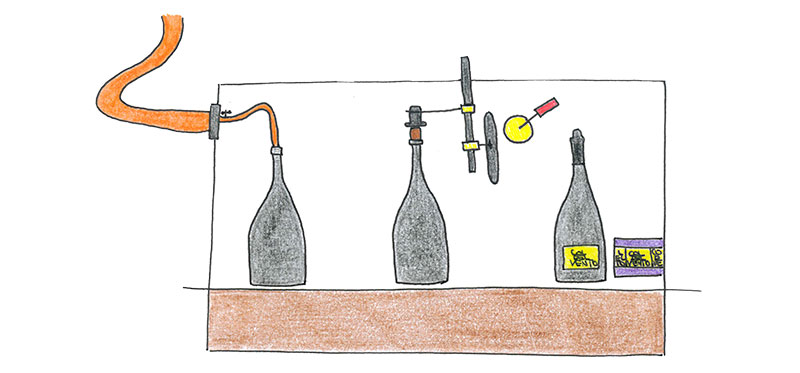HOW SPARKLING WINE IS MADE (METODO CLASSICO / TRADITIONAL METHOD)

HARVESTING
During the summertime when the grapes are ripe it is finally time to harvest. The vineyards at Col del Vento have been planted in order for the harvest to be done both manually and mechanically, using innovative machines that shake the vines to obtain only the grapes. The advantage is that the harvesting process takes less time and the grapes are immediately treated.
1
HARVESTING

PRESSING
After the grapes have been harvested, they are pressed. This process separates the solids from the liquid, which is called must. If rosé wine is being produced, the must and the peels will be kept together in the pressing machine for one night in order for the must to absorb some of the color of the peels, resulting in a rosé colored wine.
Nel caso dei vini rosati, questi restano nella pressa per una notte affinché il mosto prenda il colore dalla buccia e assumano poi quella tonalità rosa tipica di questo prodotto.
2
PRESSING

CLARIFICATION
The must then undergoes the clarification process. This stage consists of the elimination of existing solid sediments within the must. The result will be a clean must. This stage will be done only if necessary and always respecting the product.
3
CLARIFICATION

ALCOHOLIC FERMENTATION
Now the alcoholic fermentation takes place. The must is put in fermentation tanks where, with the addition of specific yeasts, the must will begin the fermentation process. It is a chemical-physical process that starts by keeping the must at a controlled temperature of 18°C for one week, during which the natural sugars within the must completely transform. During this stage the wine becomes an alcoholic beverage moving from 0% vol to around 11% vol.
4
ALCOHOLIC FERMENTATION

RAKING
The fermentation goes on for one week and subsequently the wine is ready for the racking process, during which the wine is poured into big steel tanks.
5
RAKING

SECONDARY BOTTLE FERMENTATION
At this point, the wine follows different final stages in order to transform into the desired type of wine. The sparkling wine is produced with the Traditional Method: the secondary fermentation is undertaken directly in the bottles, with or without the addition of sugar and yeast. The bottles will lay down for a minimum of 24 months to more or less 72 months. During this phase, the alcohol will move from 11% vol to around 12,5% vol.
6
SECONDARY BOTTLE FERMENTATION

REMUAGE
After the resting period the remuage is the next stage. The bottles are now moved to an oblique position and within the months this position progressively becomes more oblique, until the bottles reach a vertical position. This process allows the sediments to deposit on the bottleneck.
7
REMUAGE

DISGORGING
During the disgorging of the wine, the bottleneck is frozen to remove the sediments. A small amount of wine is added to level each bottle.
8
DISGORGING

BOTTLING
The bottling phase terminates the process.
9
BOTTLING
